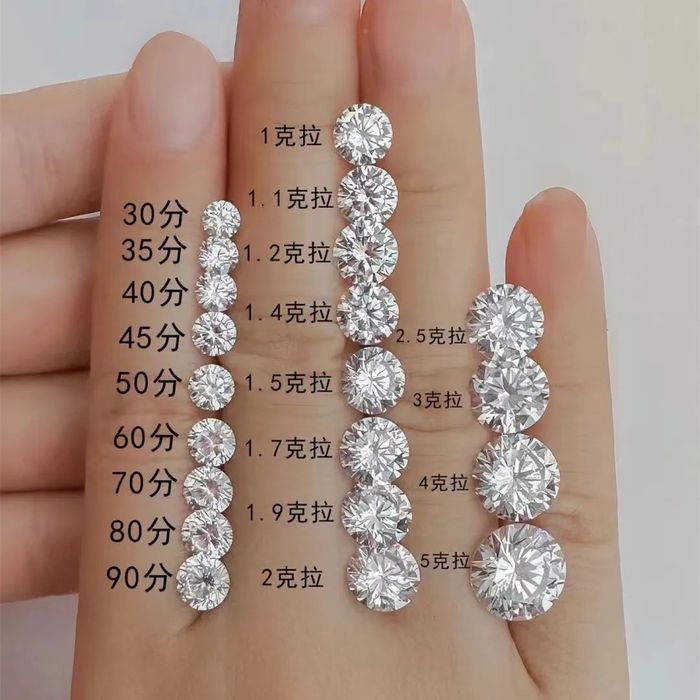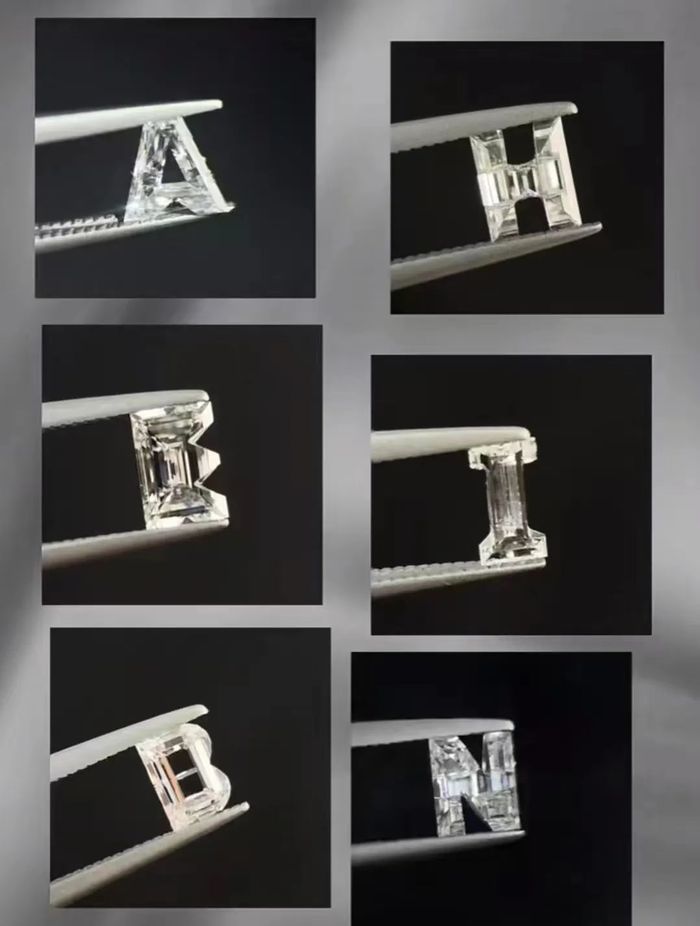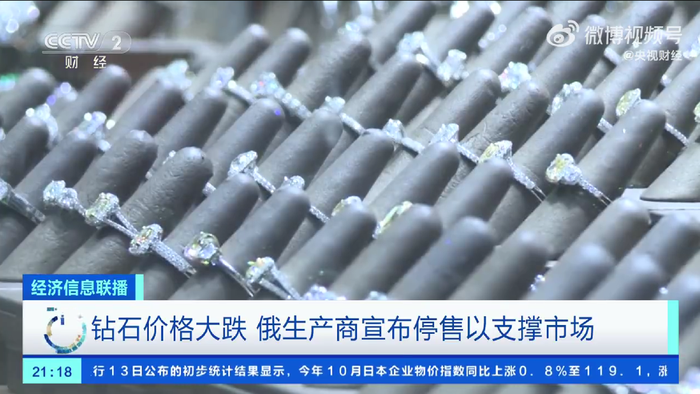China's "blood diamonds" story: Price cuts, certificates, rings are worth more than diamonds
According to statistics, since 2023, the global wholesale price of polished diamonds has fallen by about 20%, while the price of uncut diamonds has fallen by about 35%. In response, De Beers, the world's largest monopoly diamond dealer, called out "2023 is the most difficult year", while several natural diamond manufacturers chose to stop mining in order to protect diamond prices.
Some say it is because of the economic downturn, some say it is because of changes in attitudes, others say it is because of the war, the exchange rate... Behind these "differences", the large number of applications of "cultivated diamonds" may be a more fundamental reason - as a crystal composed of pure carbon, cultivated diamonds have no difference in nature from natural diamonds, and the production cost is far lower than that of mining.
In the movie "Blood Diamond", behind the circulation of a diamond are several human lives. More than a decade later, as the world's largest producer of cultivated diamonds, the Chinese market interprets another version of the "blood diamond story", which consists of price cuts, licensing, shoddy goods and liquidation. No more bloody, but no less absurd:

See | for an intuitive comparison of diamond sizes
Guo Siwen, a jewelry industry worker in Shenzhen, switched to cultivating diamonds last year.
At present, in her hands, a "top match" 1-carat cultivated diamond is priced at about 4,000 yuan, and the same size, color and clarity are slightly worse as long as 3,000 yuan.
She refers to F-color VS1/VS2 clarity diamonds as "value for money" grades.
Once, in the era of natural diamond monopoly, 20,000 yuan is only enough to buy a natural diamond of about 30 points of "cost-effective" level, and now, you can buy 3-carat cultivated diamonds at the same level.
Among Guo Siwen's peers, some even launched a 1-carat Def si (high color grade, small impurities) grade cultivation drill "naked diamond 1599 yuan price" activity.
Figure | peer advertising
In addition to being cost-effective, the drill can be customized to a wide variety of shapes, such as English letters or numbers with special meanings.
In Guo Siwen's view, "our Chinese cultivated diamonds have exploded natural diamonds."

Although cultivating diamonds has such a big advantage, for a long time, most of the sales channels of cultivating diamonds are still online, and the penetration rate of jewelry offline counters is not high.
Guo Siwen explained that when the technology was not mature earlier, the cultivation of diamonds was mostly industrial use, and it did not appear in the consumer market in some countries until around 2013. Coupled with the meager profit of cultivating diamonds, most jewelry businesses are in a wait-and-see state, and the willingness to introduce and cultivate diamond jewelry is not strong. In the past two years, the wind has changed slightly.
In Shanghai, a gold jewelry brand store to do the sister's small article said that before the diamond premium is high, the commission of selling a diamond ring is far more than gold, so the wedding group will strongly recommend diamonds.
This year she has seen a drop in customers buying diamonds in the store, and "even the slightest thought will ask if there is a breeding diamond", because of the downturn in diamond sales, she and her colleagues now prefer to recommend lower commission gold, rather than continue to recommend diamonds.
The sales figures of the major natural diamond brands also speak for themselves.
Laishen Tongling (603900.SH) had a first-half operating income of 430 million yuan, down 21.4 percent year-on-year, and Aidier (002740.SZ) had a first-half revenue of 141 million yuan, down 12.57 percent year-on-year.
The diamond monopoly "De Beers", which created the advertising slogan "diamond is forever, a diamond spread forever", began to lay out and cultivate diamonds as early as 2018, and its artificial diamond brand "Lightbox" is divided into "best" and "general" quality regardless of grade, the former is sold according to $1,500 / carat, and the latter is sold according to $800 / carat.
In fact, in 2022, more than 70% of consumers in the United States have chosen to cultivate diamonds, and cultivated diamonds have become the most popular gemstone variety for engagement rings.
Under the rapid attack of cultivated diamonds, natural diamond dealers can not withstand.
On November 14, De Beers' biggest rival and Russia's largest ore producer, Alrosa, announced an unprecedented measure: to stop selling all natural diamonds for two months in an attempt to support plunging diamond prices.

Once upstream "sanctions", is Guo Siwen's biggest "fear".
But now, when she saw the news, she smiled contemptuously. "What's the use? Don't you underestimate Henan?"
Can you imagine? Henan has the world's largest cluster of cultivated diamond industries.
Data from the superhard materials branch of the China Machine Tool Industry Association show that China's artificial diamond production accounts for 95% of the global total, while Henan's artificial diamond production accounts for 80% of the country.
Some people in order to buy a heart of the cultivation of drill, will specially drive to the cultivation of Zhecheng drill factory "crouch"; Some people also came to see business opportunities immediately after hearing that "Zhengzhou is about to build a diamond industrial park."
In fact, Henan's cultivation of the diamond industry has a long history, dating back to the last century.
Diamond, the scientific name diamond, is the core material in the abrasive industry, widely used in various infrastructure fields, known as "industrial teeth".
In the early stage of China's industrialization, diamond mainly came from Congo and the Soviet Union.
In 1960, natural disasters occurred in the Democratic Republic of the Congo, which greatly affected the local diamond industry.
After the Soviet Union cut off the supply of diamonds to China, other countries with synthetic diamond synthesis technology have also implemented a technological blockade of China. In this situation, China decided to break through the technological blockade and develop artificial diamond.
At that time, Zhengzhou Abrasives Grinding Research Institute (referred to as: Zhengzhou Three Grinding Research Institute), which has the reputation of "Whampoa Military Academy" in China's superhard materials, undertook this task.
In 1963, the Sanmo Research Institute developed China's first artificial diamond, and since then Henan has become the base of China's artificial diamond, which has laid a solid technical foundation and talent reserve foundation for the popularity of "cultivating diamonds".
Since 2006, China has become the world's largest producer of synthetic diamonds, most of which come from Henan.
By 2021, the annual production of synthetic diamonds in Henan Province alone will exceed 9 million carats.
With such a high production of synthetic diamonds, why has the price of diamonds remained high for a long time?
Li Ao, an engineer in the "diamond capital" Henan Zhecheng, explained, "Earlier, the reason was that the technology was immature at that time and could not meet the demand for jewelry diamonds, and later it was pure" business war "."
Leo introduced that the production and cultivation method of diamonds in the earlier industry was high temperature and high pressure, and most of the pieces were small particles of diamonds.
In addition, due to the chemical reaction in the synthesis process, most artificial diamonds will have impurities, or the color is yellow, and can not be used as jewelry, so the main use is in the industrial field.
In 2014, China has made a major breakthrough in the cultivation of drill technology, which can produce natural diamond products.
At this time, Indian businessmen who smell business opportunities from China to buy color, clarity and natural diamonds the same cultivated diamond blank, in India after processing mixed natural diamonds, the diamond market caused a huge impact.
In order to maintain the premium of "diamonds", natural diamond dealers maintain the "scarcity" of diamonds through various means, such as controlling production, holding frequent auctions, brand marketing, etc., and the most important one: refusing to identify and cultivate diamonds, issuing certificates. Diamonds without a certificate are "not trusted", and diamond dealers use this to suppress the cultivation of diamonds.
Qian Lin, who specializes in cultivating custom diamond inlays, described the gap as "suddenly falling from the cloud."
She said she earns only about $100 per diamond and "didn't expect diamonds to go from being the industry with the highest premium to the industry with the lowest premium."
The main styles sold by Qian Lin are "imitation models" of big brands, and the best selling styles at present come from luxury brands such as Tiffany and HW.
Since diamond prices have plummeted, fewer people are willing to pay the premium for diamond brands. People are more willing to buy imitation models than to pay a lot of money for "big name" originals that are doomed to lose value.
The huge fluctuations in prices, as well as the immature market, also leave opportunities for nurturing the "gray" area of drilling.
"At present, the most commonly used means in the industry is the 'set of certificates'", Guo Siwen explained that many sellers in the sale of naked diamonds said "package reinspection costs, certification, false one pay three", in fact, to provide Indian IGI, "Indian IGI identification is not strict in Shanghai, easy to lead to many diamonds' drop', color and clarity did not reach the level."
"In order to be more realistic, the popular practice in the industry is to directly open Indian IGI and then return to Shanghai for reinspection." Since there is mutual recognition between Shanghai IGI and Indian IGI, there will be no new rating, so what seems to get is Shanghai IGI, in fact, it is still an Indian certificate, and consumers can only eat dumb losses." Guo Siwen said.
Then there is the carat premium.
Taking 1.99 carat and 2 carat breeding drill as an example, its weight is only 0.01 carat error, about 0.002 grams, the difference may reach 1,000 yuan, some sellers see the "business opportunity", 1.99 carat in accordance with the price of 2 carats.
"Color change is also a commonly used means in the industry," Qian Lin explained that many large carat cultivation diamonds will have poor color clarity, and businesses will choose to change colors without taking the initiative to inform consumers.
For example, in the CVD cultivation diamonds, the very light brown and gray diamonds are sold as white diamonds after transformation, and the less valuable deeper brown and gray diamonds are sold after color diamonds, "although the color change has little impact on the cultivation of diamonds themselves, it is equivalent to spending money."
Indian IGI, carat premium, color change or the industry is relatively "decent" practice, more humiliating is the use of Mosang drill to fish eye mixed beads.
Qian Lin explained that cultivating diamonds and Mosan diamonds belong to the general cognition of "artificial diamonds", Mosan diamonds are another kind of ore with a similar appearance of diamonds, the two are completely different things.
More importantly, the price of the former is about 2000 yuan/carat, while the price of the latter has fallen to 100 yuan/carat.
Many people sell diamonds in the broadcast room, bullying ordinary people do not understand the difference between "cultivated diamonds" and "artificial diamonds", Shouting that artificial diamonds are cheap to sell, "you think you are buying cultivated diamonds, the result is received Mosan diamonds."
In addition, cultivated diamonds are not as strictly graded as natural diamonds, but are divided into two grades according to De Beers' practice (different names, such as De Beers called "excellent" and "average"; Guo Siwen called "top match", "sex price"), many businesses will apply the rating of natural diamonds, and some of the substandard products that should be "eliminated" will be sold at a high price.
"This industry is very much like the original Mossan diamond", Qian Lin mentioned that the Mossan diamond is also a very red moment, regarded as a "natural diamond" flat, did not think that after a few months Mossan diamond fell into the "glass price".
"No one knows where the bottom price of breeding diamonds is, and if the industry is not well managed, it may be like Moissanite."
With a shrug, Qian placed a cultured diamond ring, a replica of a classic Harry Winston design, into a box she bought for a few dozen yuan and handed it over to SF Express.
Keywords:
More Blogs
Chinese jewelry brand milestone moment! 2023 Jewelry Brand Development Conference is about to open
Real exploration jewelry exhibition: more and more buy! Jewelry spending is booming
The Shanghai Jewelry Show is a new fashion for folding jewelry






